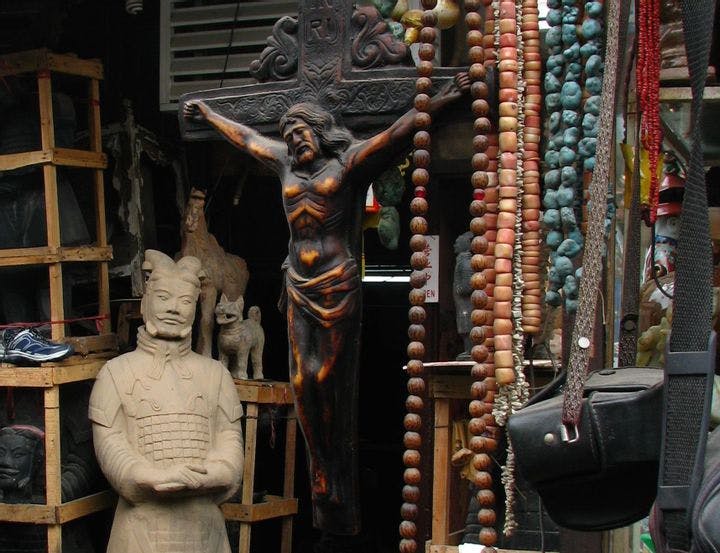Religions are growing in China — thanks, in part, to self-censorship
– Shannon Mizzi
While religious practices have grown in China, the government maintains a stance that puzzles some, but which has surprising benefits for Beijing.
Over the past 30 years, organized religion has grown at an astonishing rate throughout China, while the state’s officially endorsed religious tradition — atheism — has remain unchanged. An independent survey conducted in 2007 by Shanghai University found that around 31 percent of those Chinese polled considered themselves to be religious — three times higher than government statistics reported at the time. Similar surveys have asked respondents whether they worship gods in any form; in one study, 63.2 percent responded in the affirmative, indicating that the practice of religious rituals is more widespread than identification with an organized faith.
Boston University Professor Robert P. Weller writes about the phenomenon in a recent article in Daedalus. “Temples to local gods have popped up like mushrooms over broad sections of the rural countryside,” he writes, while “Islam is increasingly visible as Muslims from China’s far west migrate to the heavily populated east side of the country.” Christianity has grown almost everywhere, and “Daoist and especially Buddhist temples are reviving quickly as well.”
It has been difficult for the Chinese government to keep up with these rapid changes. By the time of Mao’s death in 1976, most forms of religion and religious expression in China had been deemed threats to the security of the state and thoroughly suppressed. Now, China’s government is largely forced to improvise when it comes to creating policy on religious issues. At the moment, only five religions are legally recognized: Buddhism, Daoism, Islam, Protestantism, and Catholicism. To maintain their official status, each is required to have an organized representative entity that works closely with the government to ensure that their ideals and objectives align. Since a religious tradition cannot be recognized without this formal organizational structure, any activity that takes place outside of the designated traditions is technically illegal — including the small number of Chinese who practice religions like Hinduism or Judaism, as well as the millions who visit local temples and worship indigenous gods and spirits.
Weller terms the current government strategy for dealing with public extralegal religious activity as a “one-eye open, one-eye closed” policy. “It is as if government officials agree to pretend that they cannot see, so long as followers agree to pretend that they are not breaking the rule,” writes Weller. “The state has created an open space where religion has fermented and expanded, even without a stable legal environment to support it.” This tactic — which has been historically successful in totalitarian European countries — allows unrecognized religions to continue to exist (and, in some cases, thrive) in the public sphere, while allowing for the possibility of government repression at any moment with a ready excuse: combatting flagrantly illegal activity. Thus far, Beijing has been taking action almost exclusively against groups or individuals they deem socially disruptive or who have the potential to deviate from state interests.
Why would the government choose to operate this way? Why not simply add other religious traditions to the existing state-recognized five — a move that would expand the number of legitimate religions while pulling those religions closer to the state? Weller’s answer is that the state sees significant advantages to having some forms of religion remain outside the regulatory system: It requires religions to enter the public sphere peacefully, out of fear of a crackdown. In most cases, “such situations encourage active self-censorship which is one of the reasons the policy continues,” writes Weller. “Occasional acts of repression become necessary to remind people that there is a line that cannot be crossed, even if it is invisible.”
Weller notes that “sometimes the point of a law is to state a moral ideal rather than to regulate actual practice. … Nominal acceptance of the conventions of the law may be more important to officials than substantive obedience.” On the one hand, allowing too many interest groups to become a part of the state structure in China would necessarily mean that the government would lose some of the strength in its grip on the country. On the other hand, religious practice has expanded so greatly in China that it would be foolish for the government to attempt to repress all unrecognized faiths — the state receives domestic backlash already over its authoritarian surveillance practices and censorship of art and the Internet. Of course, Beijing could decide to drop the pretense that only five religions exist in China, but for now it is clear that the benefits outweigh the costs of looking the other way.
The Source: “The Politics of Increasing Religious Diversity in China” by Robert P. Weller, Dædalus, Spring 2014.
Photo courtesy of Flickr/ingridf
